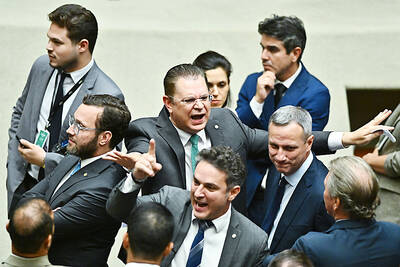Peering deep into the sea, scientists are finding creatures more mysterious than many could have imagined.
At one site, nearly 3.2km deep in the Atlantic, shrimp were living around a vent that was releasing water heated to 407 degrees Celsius. Water surrounding the site was a chilly 2 degrees Celsius.
An underwater peak in the Coral Sea was home to a type of shrimp thought to have gone extinct 50 million years ago.

PHOTO: AP
More than 4.8km beneath the Sargasso Sea, in the Atlantic, researchers collected a dozen new species eating each other or living on organic material that drifts down from above.
"Animals seem to have found a way to make a living just about everywhere,'' said Jesse Ausubel of the Sloan Foundation, discussing the findings of year six of the census of marine life.
"We can't find anyplace where we can't find anything new," Ron O'Dor, a senior scientist with the census, added.
This year's update, released on Sunday, is part of a study of life in the oceans that is scheduled for final publication in 2010.
The census is an international effort supported by governments, divisions of the UN and private conservation organizations. Approximately 2,000 researchers from 80 countries are participating.
Ausubel said there are nearly 16,000 known species of marine fish and 70,000 kinds of marine mammals. A couple of thousand have been discovered during the census.
The researchers conducted 19 ocean expeditions this year; a 20th continues in the Antarctic. In addition, they operated 128 nearshore sampling sites and, using satellites, followed more than 20 tagged species including sharks, squid, sea lions and albatross.
Highlights of this year's research included:
* Shrimp, clams and mussels living near the super-hot thermal vent in the Atlantic, where they face pulses of water that is near-boiling despite shooting into the frigid sea.
* In the sea surrounding the Antarctic, a community of marine life shrouded in darkness beneath more than 1,600 feet of ice. Sampling of this remote ocean yielded more new species than familiar ones.
* Off the coast of New Jersey, 20 million fish swarming in a school the size of Manhattan.
* Finding alive and well, in the Coral Sea, a species of shrimp called Neoglyphea neocaledonica, thought to have disappeared millions of years ago. Researchers nicknamed it the Jurassic shrimp.
* Satellite tracking of tagged sooty shearwaters, small birds, that mapped the birds' 70,000km search for food in a giant figure eight over the Pacific Ocean, from New Zealand via Polynesia to foraging grounds in Japan, Alaska and California and then back. The birds averaged a surprising 350km daily. In some cases, a breeding pair made the entire journey together.
* A new find, a 2kg rock lobster discovered off Madagascar.
* A single-cell creature big enough to see, in the Nazare Canyon off Portugal. The fragile new species was found 4,270m deep. It is enclosed within a plate-like shell, four-tenths of an inch in diameter, composed of mineral grains.
* A new type of crab with a furry appearance, near Easter Island. It was so unusual it warranted a whole new family designation, Kiwaidae, named for Kiwa, the Polynesian goddess of shellfish.
Its furry appearance justified its species name, hirsuta, which means "hairy."

PARLIAMENT CHAOS: Police forcibly removed Brazilian Deputy Glauber Braga after he called the legislation part of a ‘coup offensive’ and occupied the speaker’s chair Brazil’s lower house of Congress early yesterday approved a bill that could slash former Brazilian president Jair Bolsonaro’s prison sentence for plotting a coup, after efforts by a lawmaker to disrupt the proceedings sparked chaos in parliament. Bolsonaro has been serving a 27-year term since last month after his conviction for a scheme to stop Brazilian President Luiz Inacio Lula da Silva from taking office after the 2022 election. Lawmakers had been discussing a bill that would significantly reduce sentences for several crimes, including attempting a coup d’etat — opening up the prospect that Bolsonaro, 70, could have his sentence cut to

China yesterday held a low-key memorial ceremony for the 1937 Nanjing Massacre, with Chinese President Xi Jinping (習近平) not attending, despite a diplomatic crisis between Beijing and Tokyo over Taiwan. Beijing has raged at Tokyo since Japanese Prime Minister Sanae Takaichi last month said that a hypothetical Chinese attack on Taiwan could trigger a military response from Japan. China and Japan have long sparred over their painful history. China consistently reminds its people of the 1937 Nanjing Massacre, in which it says Japanese troops killed 300,000 people in what was then its capital. A post-World War II Allied tribunal put the death toll

A passerby could hear the cacophony from miles away in the Argentine capital, the unmistakable sound of 2,397 dogs barking — and breaking the unofficial world record for the largest-ever gathering of golden retrievers. Excitement pulsed through Bosques de Palermo, a sprawling park in Buenos Aires, as golden retriever-owners from all over Argentina transformed the park’s grassy expanse into a sea of bright yellow fur. Dog owners of all ages, their clothes covered in dog hair and stained with slobber, plopped down on picnic blankets with their beloved goldens to take in the surreal sight of so many other, exceptionally similar-looking ones.

‘UNWAVERING ALLIANCE’: The US Department of State said that China’s actions during military drills with Russia were not conducive to regional peace and stability The US on Tuesday criticized China over alleged radar deployments against Japanese military aircraft during a training exercise last week, while Tokyo and Seoul yesterday scrambled jets after Chinese and Russian military aircraft conducted joint patrols near the two countries. The incidents came after Japanese Prime Minister Sanae Takaichi triggered a dispute with Beijing last month with her remarks on how Tokyo might react to a hypothetical Chinese attack on Taiwan. “China’s actions are not conducive to regional peace and stability,” a US Department of State spokesperson said late on Tuesday, referring to the radar incident. “The US-Japan alliance is stronger and more